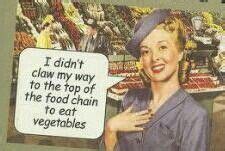THOUGHTS ON MY FAVORITE PASTIME: EATING
“We didn’t fight our way to the top of the food chain to eat lettuce.”
Larry Hanger
These days, both Ima and I are on a strict Keto diet—me by necessity driven by excessively high blood pressure and AIC numbers, Ima by choice and sympathy.
I’m constantly hungry. Everything that looks and smells good, I can’t eat; everything I can eat, I don’t want.
To make matters worse, while looking through a collection of personal notebooks, I found a listing of my twelve favorite eating experiences. So, I looked back through some old missives and dusted off a chapter in a book I was writing titled “The Future of Food.” Below are a few excerpts. Some of you who have been following my writings for years may recognize some of the thoughts.
Most of my readers know how much I love to eat. In fact, I’m a proud charter member of the “Big Dog Club,” a sobriquet earned by consistent participation over the years in numerous steak outings. The club’s name derives from our slogan: “don’t bother coming if you can’t keep up with the big dogs.”
Indeed, I can identify and separate every phase of my life with food experiences. As a youngster, I still can remember my first restaurant hamburger with mom at Mom’s Restaurant in Red Lion, Ohio (that was before Mom’s moved to its present location outside Franklin, Ohio). In my teen years, I remember my first restaurant steak—a delicious T-bone—during a family outing to Indian Lake, Ohio. During my college years at Cumberland College, in Williamsburg, Kentucky, I didn’t have two nickels to rub together and we ate at Jack’s Broasted Chicken downtown (where we would wait for someone to put a coin in the machine at their booth and we would punch in our own selection of records on the jukebox before they could make their choice). During those lean college years, a kindly lady at a truck stop outside town showed us pity by fixing us a cheap, but great-tasting, steak.
During my Air Force years, and an assignment at Kadena AFB in Okinawa, Japan, it was Kobe beef at a place called Sam’s Anchor Inn in Naha, Okinawa.
During my graduate school years at Texas Christian University in Fort Worth, Texas, it was a beef brisket sandwich at Angelo’s, amid a décor of sawdust-covered floors and moth-ridden bears and other stuffed animals. (The state of Texas has since forced the owners of Angelo’s to clean the sawdust off the floors, so the place has lost some of its folksy charm, but the sandwiches or brisket platters are still terrific!) But no brief mention of my Fort Worth period would be complete without noting The Ol’ South Pancake House. In the old days, the restaurant sat in a small wooden building next to the railroad tracks before it moved to its present location near the zoo and Trinity Park. That was during my wild days, where the winner of our poker games—Eustace, Robert, and Gene were the stalwart players—would use their winnings to buy the humble losers a late-night breakfast, usually somewhere between two and three a.m. One such night, as we were seated in the main section of the Ol’ South, a group of Arab men and women, dressed in long raincoats, came in and seated themselves at a long table in the middle of the room. They were laughing and raucous. Then, suddenly, they began clapping and shouting. A woman who was with them was helped up to the table, shed her raincoat, and started to prance up and down the table. She wore a beautiful Arabesque gown—like a jeweled princess out of the Arabian Nights—which highlighted her ample female assets. Then she began the rhythmic gyrations of a belly dance. What a dance it was! The best I’ve seen before or since. Even the Mexican cooks in the back came out to watch, and whistle, and joined the throng of restaurant patrons throwing dollar bills on the table.
Ah, the Ol’ South …
During my years traveling for the intelligence community in Asia and the Pacific, my culinary quest was for the region’s “Holy Grail”—the greatest steak or ultimate hamburger. In Kuala Lumpur, Malaysia, Tom and I hit the jackpot at the Coliseum, a holdover restaurant from the British colonial era, where a tuxedo-dressed waiter tied a bib around our necks before serving us an amazing rump-sized steak upon which he poured gravy, creating a plume of smoke that arose to the high ceiling overhead. These grease-filled smoke columns joined a proud collection of brownish circles accumulated over the years.
Ah, what a steak!
In Jakarta, Indonesia, Tom and I enjoyed an amazing Chinese meal, but only after an adventurous walk through the jungle foliage and crossing a rickety wooden bridge over a sewage-infested creek. As we ate, we ignored the onlooking glares of the cook’s children who would finish what we left on the table. One of my most memorable meals in Jakarta came years later, when Bob, Terry and I visited the Java Pub, an amazing late-night watering hole with Western food and music. At the time, the place was surrounded by Indonesian policemen protecting the patrons against roaming bands of extremist Muslim groups. Indonesia—a country with the world’s largest Muslim population—during those years of Bush’s “Global War on Terror,” was wracked by political and religious convulsions, culminating in a violent campaign to close down Western bars and clubs. That was outside. Inside, the music was fantastic—wonderful guitar-driving vintage songs from the sixties and seventies—and the tasty hamburger and fries added to the atmosphere.
In Bangkok, Thailand, it is hard to beat Neil’s Tavern. I loved the German-style ambience of the place (and its steak) enough to use it as a setting in one of my novels.
In Manila, Philippines, I remember a forced candlelight meal, during one of the many “brownouts” that characterized the power shortages of the Ramos era. Much later, on one memorable trip to Angeles City, Philippines—adjacent to Clark AFB, which was, at one time, the most beautiful military base in Asia prior to the explosion of Mount Pinatubo—I ran into a group of extraordinary expats (who stayed on after their military years). They had trained local Filipina mamasans to fix amazing American-style cuisine, and at one expat-owned restaurant there, The New Orleans House, I enjoyed a meal of fried chicken, mashed potatoes and gravy, and a piece of pie that rivalled anything my grandma could cook (and she was a great cook).
During my several visits to Singapore, I was constantly on the hunt for the city-state’s ultimate steak, hamburger and pizza. One eating experience stands out above the others. Our counterparts invited me to a special meal at the Banana Leaf Apollo restaurant in the Little India section of the city. When they told me the meal would be fish-head curry, I had visions of anchovy-heads in a bowl of curry-tinged rice. Instead, the fish head was a giant Sturgeon head and as honored guest, they carved the out best meat—the tender flesh below the eye socket—specially for me. It was delicious! Singapore, with its broad array of cultural food types, offered amazing eating opportunities.
“Down under” has its own culinary charms. In Canberra, Australia (where they roll up the sidewalks at 5:00 p.m.), I joined Henry and Paul for a fantastic steak at the Charcoal House. I have been there several times since. In the rotating restaurant atop the tower that dominates the skyline in Sydney, Australia, I tried camel, alligator, snake and dog meat for the first—and last—time. In beautiful Wellington, New Zealand, it was an incredible Belgian restaurant.
Ah, the overseas memories … and the food!
Indeed, I have been blessed with enough eating adventures for two or three lifetimes, along with the company of good friends for each “feedbag” stop.
About four years ago now, I read an interesting article on how food, and peoples’ eating habits, will change over the next twenty years. The article was by Marius Robles, CEO and co-founder of Reimagine Food (a company that bills itself as “the world’s first disruption center focusing on anticipating the future of food”).[1]
It was a fascinating piece. Robles’ speculations included the following possibilities:
Within 20 years, the word “flavor” will fall into disuse, sugar will become the new cigarettes, humans will “drink synthetic wine, scramble eggs that do not come from chickens, grill meat that was not taken from animals, and roast fish that never saw the sea.”[2] At the same time, dramatic changes will take place in the way we cultivate and consume food (at present, fully three quarters of the world’s food is derived from just 12 plant and five animal species). Anticipated new technologies will mean meat grown in labs (the article preceded vegetable-hamburger replacements now commonly available in fast food restaurants), robotic and urban farming, and hydroponics.
In the future, individual food choices are likely to be limited by government decree. Future cooperation between government and hi-tech commercial giants will embrace China’s so-called “social credit plan” (reinforced by big data and monitoring improvements assisted by artificial intelligence) and institute a nutritional credit score. Everything we eat, our level of food waste, and our carbon footprint will be carefully monitored by a kind of food police. “The sum of all these elements results in our CFS (Citizen Food Score).” Algorithms will be able to analyze everything about us—including our food habits. This means that when you try to use your fingerprint [or other biometric ID], use an automated vending machine, buy groceries, or even to buy an airplane ticket, or travel abroad, a negative score will prevent you from buying, selling or using essential products, either because it would exceed your predetermined carbon level or because you have already ingested the necessary calories for that day … [algorithmic calculations can be] used to impose significant fines when a high level of waste is detected.[3]
In addition, no doubt in the name of ensuring our safety and environmental protection, the government will usher in creative food-related taxes and monitors. Within 20 years, Robles predicts there will be the equivalent of a Food Consumption Tax Agency, which gathers data on the way we eat by means of digital implants or tattoos. “The government makes everyone ingest an edible nanorobot every six months to assess our food’s risk for our health and the environment. Insurance companies have started to offer policies with premiums that vary according to our health habits. Thanks to those implants, they are able to track almost everything in real time.”[4] It follows that insurance companies will have a large say in the future concerning what we eat.
(As an aside, I’ve had a brief glimpse of this future world due to the Freestyle Libre 2 Sensor patch-device which I attach every two weeks to my arm. It is a wonderful device and allows me to monitor my glucose levels on my cell phone. I can elect to share my data with diabetes personnel, but if I do so, I agree to share the data with a much broader medical research community. In 2022, legal privacy concerns make sharing such data a matter of my choice—I am almost certain such individual prerogatives will evaporate in the future.)
Back to Robles’ article. Kitchens and the whole process of cooking and preparing food also will change significantly in the future. Humans will have kitchen bioreactors, together with a whole series of smart cooking devices able to prepare any dish or recipe. Robotic greenhouses will be able to produce food at high speed and hybrid foods will be common; there will be tele-transported food (instead of sending the food, humans will send data; once purchased, humans will be able to use 3D food printers to replicate favorite dishes at home in a matter of seconds; powdered food synthesizers will allow 10 or 20 different flavors in each bite. By then, hi-tech companies will have digitized every foodstuff in the world, making it possible to 3D print them).
Two decades from now, artificial intelligence will become enmeshed in every aspect of our lives, including our food—each citizen will be assigned a flavor predictive algorithm (similar to a culinary DNA) “which logs every memory and taste linked to food from our earliest childhood.”[5] The algorithm understands our food needs, anticipates our moods, and can instruct the cooking devices to prepare the most appropriate dishes. Everything is recorded in a single database. Restaurants, likewise, will have sensor suites into which customers can download relevant data; customers may also provide a saliva sample (to cross-reference genetic studies for food intolerances).
All this may be the wave of the future, but then again, we are using the same basic design for flush toilets as envisioned in the late sixteenth century by Sir John Harington.
At any rate, let me close with one of my very favorite food stories. Most of my family, close friends and former students have heard this one before. As with many of my personal misadventures, it involves my younger sister Debbie.
Many years ago, I returned from a trip out West and flew back into Knoxville, Tennessee. Debbie—who still lives in Knoxville where she holds a senior-level administrative nursing position at the University of Tennessee Hospital—was kind enough to pick me up at the airport.
Of course, the first thing we did was stop on the way back to get something to eat.
In those days, there was a fantastic Western Steer restaurant on the Alcoa Highway near the airport. (The restaurant was originally opened by my good friend Bill Phillips).
One of today’s great tragedies is that it is nearly impossible to find a good Western Sizzlin or Western Steer these days.
But back to my story.
At the Western Steer, Debbie and I stopped for a steak. I ordered the steak tips with green peppers and onions—my favorite meal. It came with an enormous baked potato and a slab of Texas toast. Yum!
We seated ourselves in a little alcove area on the side, near the windows where we could see outside. An elderly couple was enjoying their meal directly across the narrow aisle from us.
I was so hungry from the trip that I took a huge forkful of steaming hot baked potato slathered with butter and, without thinking, shoved it into my mouth.
It was molten hot!
You know how you use your tongue to roll things around in your mouth when you have taken too big a bite of something hot?
Well, I was in the process of doing that when—all of a sudden—I felt the urge to sneeze.
And with that urge, an inner feeling of impending disaster.
They say the mind slows down when faced with such a crisis and the microseconds which followed unfolded in slow motion.
I knew that if I sneezed, with my mouth crammed full of steamy hot potato, across the table and in the direction of my sister, that would be a catastrophe.
So, as any polite brother would do in similar circumstances, I placed my hand over my mouth.
Even the best of intentions can result in unintended consequences (Akers’ fourth law of the universe).
Physics trumped my best intentions.
The pressure of the sneeze inside my mouth—which my hand was clamped tightly over—pried open tiny portals at both sides of my lips.
Two jet streams of molten mashed potato shot out—almost at the speed of sound—from both apertures simultaneously. One stream smashed into the window on my immediate left. The other almost picked off the elderly lady sitting on my right before crashing harmlessly, but loudly, into the brick wall on her other side.
In some circumstances, even the most heartfelt of apologies fall short.
Debbie, of course, (as sisters are prone to do) took great delight at my misfortune.
[1] Marius Robles, “It’s the year 2038—here’s how we’ll eat 20 years in the future,” FastCompany, Aug 23, 2018.
[2] Ibid.
[3] Ibid.
[4] Ibid.
[5] Ibid.




